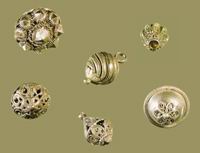Oľga Danglová
Shells, stones, teeth, bones, wood, phloem, amber, beads, decorative seeds and colourful bird feathers can all be used to decorate the body, hair or clothes like a jewel. It is presumed that in some natural nations living under the hot sun, the jewel replaced clothing and showed deeper symbolism – protection against bad forces, erotic attraction and fertility. Gradually the variety of materials, forma, types of decorations and their use was broadened and adapted according to the technical possibilities, needs and style of the period. The real development in jewellery took place mainly during the Bronze Age and was connected with the discovery of metals – copper, zinc, lead, silver and gold – and improvements in processing technologies. There are several archaeological findings from the later period of Great Moravia demonstrating developed jewellery making. This used techniques of decorating metal using filigree, granulation, gold plating, embossing and engraving. The repertoire of Great Moravian jewellery is also broad. There is a surprising similarity between the Old Slavic jewellery and the jewellery that spread throughout Slovakia in the 19th and 20th centuries. We would notice this if we placed a silver ring from the 12th Century and a brass ring of folk provenience from the Liptov and Orava regions next to each other. There is also an astonishing similarity between the round buttons from the 9th and 10th centuries and silver buttons from the clothes of richer bourgeois in Slovakia dating from the beginning of the 20th Century. It seems that Great Moravian jewellery continued and lasted into folk jewellery. However, the reality is not so simple. With few exceptions, Roman, gothic, renaissance and baroque jewellery have not lasted in their real shape because jewellery is a soft and fragile thing, and gets used up very easily, jewellery given to the church was used for making sacral objects, and jewellery went hand in hand with fashion and was constantly changing. However, old paintings and portraits are a helpful source of pictorial information. In the 14th and 15th centuries, the centres of jewellery making were concentrated in the cities: Gothic jewellery making flourished in Košice, Bratislava, the mining districts of the central Slovak and Spiš region cities. The towns of Banská Štiavnica and Kremnica were one of the largest centres for gold mining in Europe during the 14th Century. The development of jewellery making culminated in the 16th and 17th centuries with the renaissance fad in luxury. In the 18th Century, Hungary –and Slovakia within it– were ravaged by wars, and the people lost interest in jewellery. This decline in the jewellery craft continues into the 19th Century. Machine production increased the opportunity for bijouterie. A certain revival in expensive jewellery comes about by the Empire, Biedermier and mainly Secession. Jewellery from Czech pyrope is valued for its dark and shiny beauty. An artistic shift in relation to jewellery can be noted in the second half of the 20th Century. Artists from other art fields – ceramics, glass, scenographers started to be interested in jewellery as an object of artistic expression, and they started to experiment with non-traditional materials such as textile, paper, plastic, wood and leather, striving to fix their topical view of life into jewellery.
